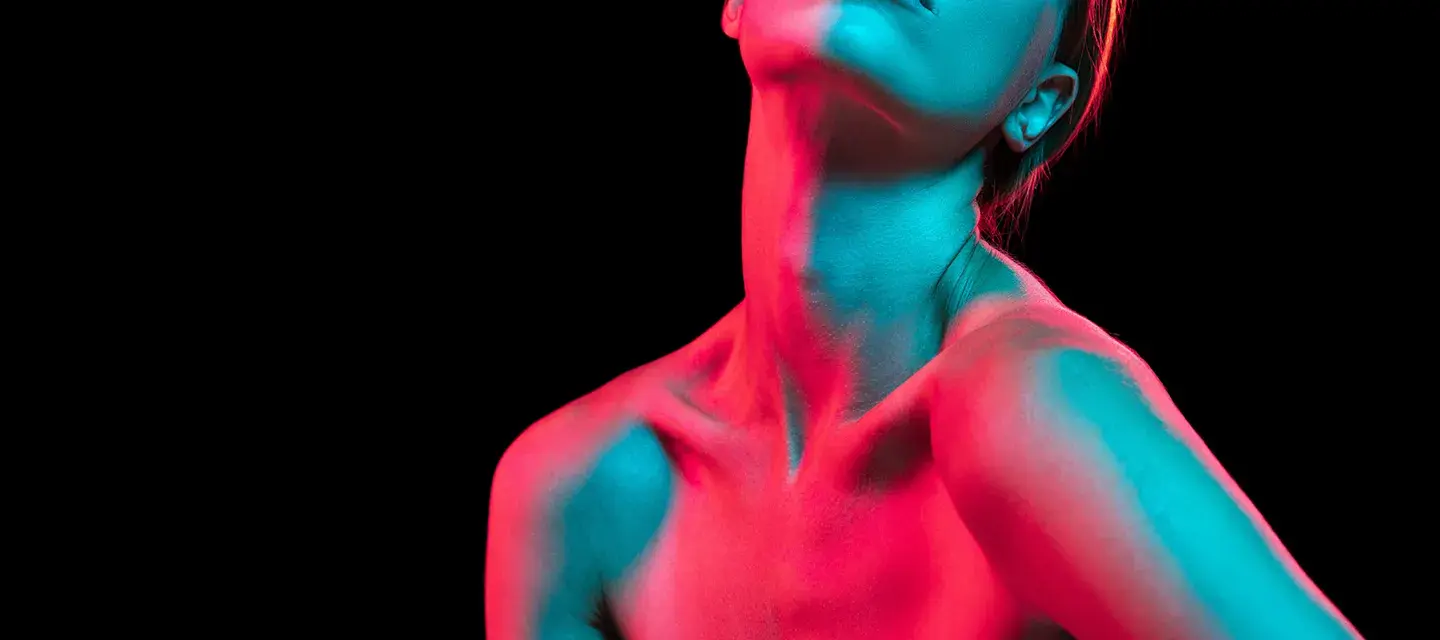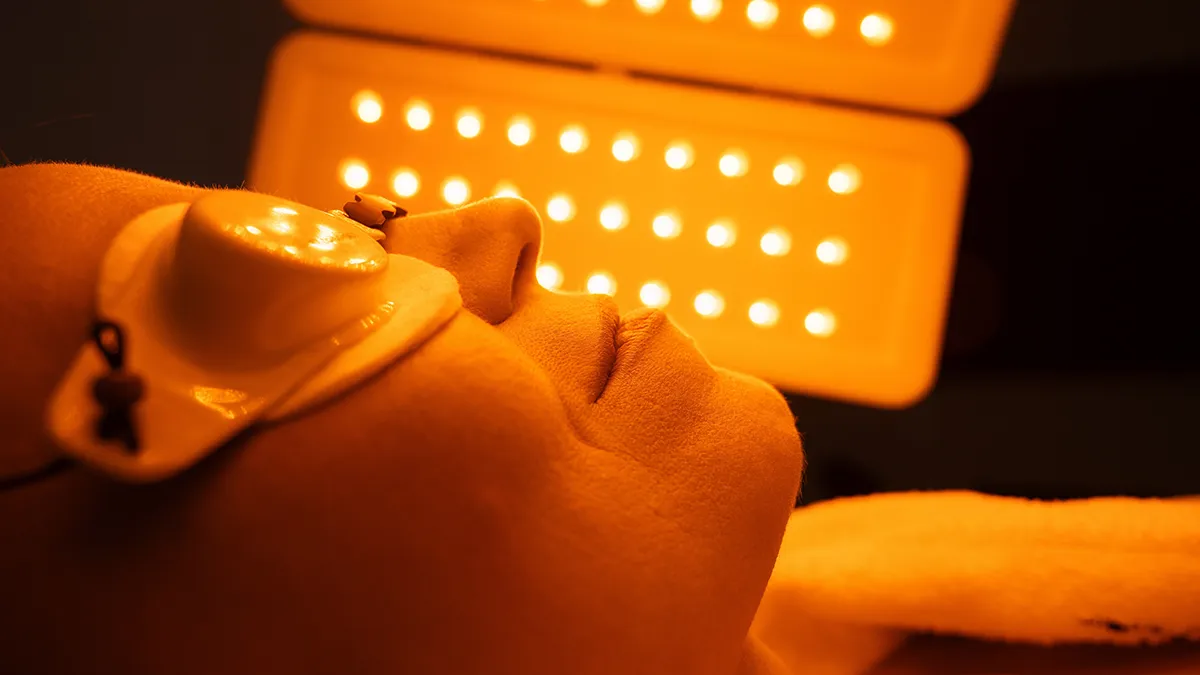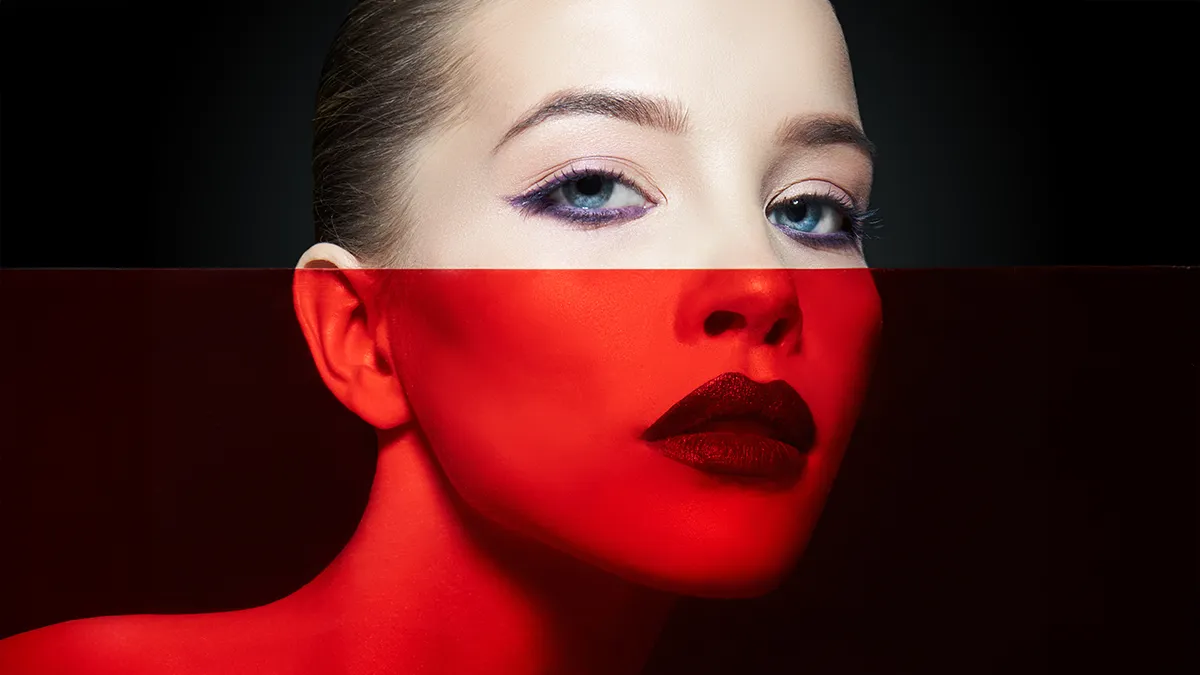7 min read
What are NIR Lights & LED Light Therapy?

First, let’s get this clear: LED is NIR, NIR is LED. NIR (near-infrared) is just another wavelength in a full-spectrum LED light therapy. Most advanced LED therapy devices on the market will include NIR in their repertoire, because it goes deeper into the skin and tissues than red light therapy. This property is due to its nature of being caught between the visible LED spectrum (approximately 380 to 700 nanometers) and the invisible IR (infrared) part of the spectrum.
So, LED and near-infrared (NIR) light therapies - that have been taking over the beauty world since Dr. Mester kept a couple of shaved mice in the name of cancer research and since NASA grew some space salad in the stratosphere, probably rockets (lame joke winner!) — are one and the same.
These modern light-based solutions are part of a broader field called phototherapy for skin and are not competing treatments, but a part of the same movement towards non-invasive, holistic, pain-free, zero-recovery, sustainable, and effective anti-aging. Visible LED and near-infrared LED light therapies are also so safe that you can do them alone at home with practical contemporary skincare devices.
But do you know what LED and NIR actually stand for, what their respective effects on the skin are, and how they differ in properties? What are the specific biological responses in the body, especially for skin health and rejuvenation, when using these controlled wavelengths of light? All of this and so much more, coming right up.
LED light vs NIR: Commonalities and Differences?
Both LED facial treatments and NIR skin therapy are forms of light-based skin treatment that fall under the overarching category of phototherapy. LED and NIR are both abbreviations of the full name of the technology / light wavelength. LED stands for Light-Emitting Diode, while NIR stands for Near-Infrared Light, but they’re most known by their nicknames and get freaked out that they’ll be in another LED light study (there are many) if you call them by their full name.
The entire range of visible and infrared wavelengths (including NIR lights) is not just light for the sake of not stepping on a Lego (visible) or just warming the body from the inside (IR). It affects cellular activity, and different wavelengths also differ in their effects within the cell. So, it is a kind of “you wouldn’t use a fork to eat soup” situation. You have appropriate tools for various skin needs at your disposal if you choose a full-spectrum LED face mask. But what does each color of light do for the skin?

Benefits of Using Different LED Lights
If you’re rummaging through light here for the purpose of finding the perfect skin rejuvenation therapy (aren’t we all), red and near-infrared wavelengths have been occupying the lab staff’s time when it comes to the very lucrative field of anti-aging. They’ve been well studied for skin repair, collagen and elastin boost, skin firmness improvements, wrinkle prevention, and generally hiding our face from the effects of time for as long as possible. So what do red LED facial and NIR skin therapy do?
Red LED light vs NIR
- Red LED light therapy (visible spectrum) primarily focuses on cosmetic and dermatological outcomes, such as skin rejuvenation, acne light therapy, LED therapy for inflammation, and anti-aging therapy, which targets the top and mid skin layers.
- NIR skin therapy uses wavelengths in the infrared light color range (700–1,100nm), invisible to the naked eye but able to penetrate deeper into tissues. This makes them useful not only in infrared light LED skincare devices but also in physical therapy, sports medicine, and pain management.
In essence, red light vs near-infrared light is not a competition but a complement working on the surface and deep skin and tissue levels. But don’t be fooled by marketing tricks of extreme penetration depths. Keep in mind that there is no ridiculous difference in penetration between red and NIR. Depending on the power, purity, and skin contact of the light source, as well as the properties of the skin itself (hydration, fat layer, body region), the penetration difference can be as little as a few millimeters. Still, these few millimeters make a big difference in skin, an organ that varies in thickness from 0.5 to 5mm. If you go deeper into infrared, you’ll get some bone, brain, and deep tissue penetration, and a little goes a long way.

You could go deeper with a stronger device, but past a common-sense point, you risk overheating the tissues, which can be somewhat reduced by pulsing the light. But what does the rest of the visible and IR spectrum do for the skin?
Visible LED
Violet Light (380–450 nm)
Rarely used in skincare devices
Sometimes explored for surface-level antibacterial effect, but blue is better studied for these purposes
Blue Light (450–495 nm)
- Anti-bacterial and ideal to target acne-causing bacteria
- Perfect to treat existing and minimize future breakouts
- Also reduces surface inflammation
Green Light (495–570 nm)
- Ideal for blotchy complexion and sunspots
- Brightens skin and evens skin tone
- Reduces visibility of hyperpigmentation
Yellow Light (570–590 nm)
- Perfect for sensitive and dull skin
- Soothes redness and stress
- Improves circulation for a healthy, well-oxygenated look
Orange Light (590–620 nm)
- For tired skin with a rough texture
- Revitalizes skin and boosts youthful glow
- Improves skin texture, making it smoother and softer
Red Light (620–700 nm)
- Has the most research backing the anti-aging effects
- Wrinkle prevention and fading fine lines
- Stimulates collagen & elastin for plump, taut skin
Invisible IR
Near-Infrared (NIR) (700–1100 nm)
- Penetrate deeper than red light
- Ideal for skin repair treatments in the deeper layers
- Faster wound healing benefits
- Boost collagen production
- Reduce inflammation in the top and deeper skin layers
- Pain management uses
Mid-Infrared (1100–3000 nm)
- Most often used in infrared saunas, penetrates deeper than NIR
- Heating sensation in the body
- Improves circulation and promotes relaxation
Far-Infrared (3000 nm–1 mm)
- Deep heat is used for thermal therapies
- More intense circulation support
- Profuse detox sweating
Can anyone see NIR lights?
Well, yes and no. If you count animals under "anyone" (cats are basically people), then yes. If you don't (shame on you), then no. Some salmon, goldfish, vipers, foxes, mosquitoes (just found out that's one of the ways they find a warm body to bite), bats, wolves, and frogs can. However, humans can't see infrared, not even tetrachromates (people who can see up to 100 million colors, as opposed to the 1 million colors a regular Joe sees) can penetrate that far into the spectrum, where the wavelength pertains more to heat than light. We don’t have the sense organs to capture this.
So, NIR (Near-Infrared) LED light is mostly invisible to the human eye because its wavelengths (about 700–1100 nm) extend beyond the visible spectrum, but at the very edge of the spectrum (around 700–750 nm), just as we’re transitioning into IR, some people may perceive a very faint deep red glow. But, beyond ~800 nm, it’s completely invisible. That’s why good LED device manufacturers sometimes add a small visible red LED next to the NIR, so you’ll know your NIR light is turned on. To your naked eye, it may seem that nothing is happening, although your goldfish would be going, “Whoaaa!”
The Most Popular LED Skin Repair Treatments
Generally, if you want a whole body treatment, a larger red light panel is a great choice, although some of the light may get dispersed. But, if you’re really concerned about penetration on the facial skin, you’d be about 60% better off by choosing an LED mask or LED therapy device in direct contact with the skin. LED therapy benefits depend more on intensity, wavelength, and tissue interaction than on large differences in depth.

Once, you would have had to go to a salon, studio, or clinic to get your LED facial treatment or NIR skin therapy, but some very good people have worked hard to make these technologies available in the daily lives of millions around the globe who might not have the time or resources to get regular professional treatments. At-home LED devices from popular brands such as FOREO and FAQ™ Swiss now make it simple to receive clinical-quality LED facial treatments and anti-aging therapy, all while shuffling around your kitchen in bunny slippers.
While FOREO has some great devices using red or near-infrared wavelengths, such as UFO™ 3, UFO™ 3 LED, LUNA™ 4 plus, or the acne light therapy with ESPADA™ 2, ESPADA™ 2 plus, or KIWI™. If you’re interested in intense non-invasive LED therapy anti-aging, on the other hand, maybe you are better off exploring the FAQ™ Swiss red LED and NIR skin therapy:
FAQ™ 100 Collection
- FAQ™ 101 RF & Red Light Wand For Face
- FAQ™ 102 RF, EMS & Red Light Anti-aging Wand For Face
- FAQ™ 103 Diamond-adorned RF, EMS & Red Light Wand
FAQ™ 200 Collection
- FAQ™ 201 Silicone LED Face Mask
- FAQ™ 202 Anti-aging Silicone LED Mask
- FAQ™ 202 plus LED face mask
- FAQ™ 211 Red Light Neck & Décolleté Mask
- FAQ™ 221 Anti-aging Red LED Hand Mask
FAQ™ 300 Collection
- FAQ™ 301 LED Hair Strengthening Scalp Massager
- FAQ™ 302 Laser & LED Hair Regrowth Scalp Massager
FAQ™ 400 Collection
- FAQ™ 401 Dual Microcurrent LED Toning Device
- FAQ™ 402 Dual Microcurrent Red LED Toning Device
- FAQ™ 411 Microcurrent Red LED Body Toning Device
FAQ™ 500 Collection
- FAQ™ 501 Full Spectrum Red Light Therapy
- FAQ™ 502 Full Spectrum Red Light & NIR Therapy
FAQ™ LED Light Therapy Panels
- FAQ™ LED Panel (Single)
- FAQ™ Dual LED Panel
5 Things to Remember Before Using NIR or LED
1. Talk to your dermatologist/GP or licensed skincare professional
They will assess your skin type and specific concerns, such as potential melanoma risk, to tailor a personalized NIR/LED treatment plan. There are also some medical conditions in which you shouldn't use LED therapy.
2. Consider scheduling professional NIR treatments
If you are looking for a more intensive and customized approach or need help treating a specific skincare condition, such as acne or rosacea, consider professional treatment.
3. Combining NIR and LED with skincare products
Pairing NIR/LED treatments with skincare products rich in antioxidants and ingredients that promote collagen production can enhance the overall results.
4. Safety precautions
Both LED and NIR therapies are generally safe and non-invasive. However, it's essential to follow the recommended guidelines and safety instructions provided by the manufacturer or healthcare professional.
5. Treatment Duration and Frequency
Different LED and NIR devices may have varying treatment times and recommended frequencies. Some treatments may require several sessions to achieve the desired results. Understand the time commitment involved and adhere to the treatment schedule consistently to maximize the benefits.








Comments
1 comments
Leave a comment